International Maritime Organization
The International Maritime Organization (IMO) (French: Organisation Maritime Internationale (OMI), known as the Inter-Governmental Maritime Consultative Organization (IMCO) until 1982,[1] is a specialised agency of the United Nations responsible for regulating shipping. The IMO was established following agreement at a UN conference held in Geneva in 1948[2] and the IMO came into existence ten years later, meeting for the first time in 1959.[3] Headquartered in London, United Kingdom, the IMO currently has 174 member states and three associate members.[1]
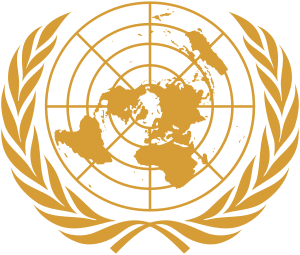 | |
 | |
| Abbreviation | IMO, OMI |
|---|---|
| Formation | 17 March 1948 |
| Type | United Nations specialised agency |
| Legal status | Active |
| Headquarters | London, United Kingdom |
Head | Secretary-General |
Parent organization | United Nations Economic and Social Council |
| Website | www.imo.org |
The IMO's primary purpose is to develop and maintain a comprehensive regulatory framework for shipping and its remit today includes safety, environmental concerns, legal matters, technical co-operation, maritime security and the efficiency of shipping. IMO is governed by an assembly of members and is financially administered by a council of members elected from the assembly. The work of IMO is conducted through five committees and these are supported by technical subcommittees. Other UN organisations may observe the proceedings of the IMO. Observer status is granted to qualified non-governmental organisations.
IMO is supported by a permanent secretariat of employees who are representative of the organisation's members. The secretariat is composed of a Secretary-General who is periodically elected by the assembly, and various divisions such as those for marine safety, environmental protection and a conference section.
History
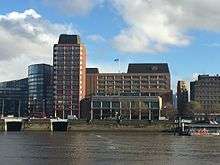
SOLAS
Inter-Governmental Maritime Consultative Organization (IMCO) was formed in order to bring the regulation of the safety of shipping into an international framework, for which the creation of the United Nations provided an opportunity. Hitherto such international conventions had been initiated piecemeal, notably the Safety of Life at Sea Convention (SOLAS), first adopted in 1914 following the Titanic disaster.[1] IMCO's first task was to update that convention; the resulting 1960 convention was subsequently recast and updated in 1974 and it is that convention that has been subsequently modified and updated to adapt to changes in safety requirements and technology.
When IMCO began its operations in 1959 certain other pre-existing conventions were brought under its aegis, most notable the International Convention for the Prevention of Pollution of the Sea by Oil (OILPOL) 1954. The first meetings of the newly formed IMCO were held in London in 1959.[4] Throughout its existence IMCO, later renamed the IMO in 1982, has continued to produce new and updated conventions across a wide range of maritime issues covering not only safety of life and marine pollution but also encompassing safe navigation, search and rescue, wreck removal, tonnage measurement, liability and compensation, ship recycling, the training and certification of seafarers, and piracy. More recently SOLAS has been amended to bring an increased focus on maritime security through the International Ship and Port Facility Security (ISPS) Code. The IMO has also increased its focus on smoke emissions from ships.
In January 1959, IMO began to maintain and promote the 1954 OILPOL Convention. Under the guidance of IMO, the convention was amended in 1962, 1969, and 1971.
Torrey Canyon
As oil trade and industry developed, many people in the industry began to recognise a need for further improvements in regards to oil pollution prevention at sea. This became increasingly apparent in 1967, when the tanker Torrey Canyon spilled 120,000 tons of crude oil when it ran aground entering the English Channel[5]
The Torrey Canyon grounding was the largest oil pollution incident recorded up to that time. This incident prompted a series of new conventions.[5]
Maritime pollution convention
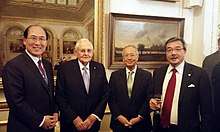
IMO held an emergency session of its Council to deal with the need to readdress regulations pertaining to maritime pollution. In 1969, the IMO Assembly decided to host an international gathering in 1973 dedicated to this issue.[5] The goal at hand was to develop an international agreement for controlling general environmental contamination by ships when out at sea.
During the next few years IMO brought to the forefront a series of measures designed to prevent large ship accidents and to minimise their effects. It also detailed how to deal with the environmental threat caused by routine ship duties such as the cleaning of oil cargo tanks or the disposal of engine room wastes. By tonnage, the aforementioned was a bigger problem than accidental pollution.[5]
The most significant thing to come out of this conference was the International Convention for the Prevention of Pollution from Ships, 1973. It covers not only accidental and operational oil pollution but also different types of pollution by chemicals, goods in packaged form, sewage, garbage and air pollution.[3]
The original MARPOL was signed on 17 February 1973, but did not come into force due to lack of ratifications. The current convention is a combination of 1973 Convention and the 1978 Protocol. It entered into force on 2 October 1983. As of May 2013, 152 states, representing 99.2 per cent of the world's shipping tonnage, are involved in the convention.[3]
In 1983 the IMO established the World Maritime University in Malmö, Sweden.
Headquarters
The IMO headquarters are located in a large purpose-built building facing the River Thames on the Albert Embankment, in Lambeth, London.[6] The organisation moved into its new headquarters in late 1982, with the building being officially opened by Queen Elizabeth II on 17 May 1983.[6] The architects of the building were Douglass Marriott, Worby & Robinson.[7] The front of the building is dominated by a seven-metre high, ten-tonne bronze sculpture of the bow of a ship, with a lone seafarer maintaining a look-out.[7] The previous headquarters of IMO were at 101 Piccadilly (now the home of the Embassy of Japan), prior to that at 22 Berners Street in Fitzrovia and originally in Chancery Lane.[4]
Membership
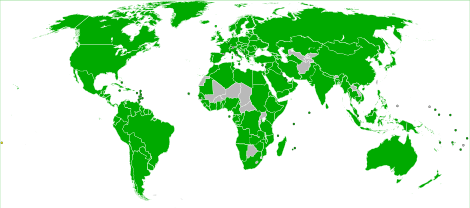
To become a member of the IMO, a state ratifies a multilateral treaty known as the Convention on the International Maritime Organization. As of 2020, there are 174[8] member states of the IMO, which includes 173 of the UN member states plus the Cook Islands. The first state to ratify the convention was the United Kingdom in 1949. The most recent members to join were Armenia and Nauru, which became IMO members in January and May 2018, respectively.[9]
These are the current members with the year they joined:
Albania (1993)
Algeria (1963)
Angola (1977)
Antigua and Barbuda (1986)
Argentina (1953)
Armenia (2018)
Australia (1952)
Austria (1975)
Azerbaijan (1995)
Bahamas (1976)
Bahrain (1976)
Bangladesh (1976)
Barbados (1970)
Belarus (2016)
Belgium (1951)
Belize (1990)
Benin (1980)
Bolivia (1987)
Bosnia and Herzegovina (1993)
Brazil (1963)
Brunei Darussalam (1984)
Bulgaria (1960)
Cabo Verde (1976)
Cambodia (1961)
Cameroon (1961)
Canada (1948)
Chile (1972)
China (1973)
Colombia (1974)
Comoros (2001)
Congo (1975)
Cook Islands (2008)
Costa Rica (1981)
Côte d'Ivoire (1960)
Croatia (1992)
Cuba (1966)
Cyprus (1973)
Czechia (1993)
Democratic People's Republic of Korea (1986)
Democratic Republic of the Congo (1973)
Denmark (1959)
Djibouti (1979)
Dominica (1979)
Dominican Republic (1953)
Ecuador (1956)
Egypt (1958)
El Salvador (1981)
Equatorial Guinea (1972)
Eritrea (1993)
Estonia (1992)
Ethiopia (1975)
Fiji (1983)
Finland (1959)
France (1952)
Gabon (1976)
Gambia (1979)
Georgia (1993)
Germany (1959)
Ghana (1959)
Greece (1958)
Grenada (1998)
Guatemala (1983)
Guinea (1975)
Guinea-Bissau (1977)
Guyana (1980)
Haiti (1953)
Honduras (1954)
Hungary (1970)
Iceland (1960)
India (1959)
Indonesia (1961)
Iran (1958)
Iraq (1973)
Ireland (1951)
Israel (1952)
Italy (1957)
Jamaica (1976)
Japan (1958)
Jordan (1973)
Kazakhstan (1994)
Kenya (1973)
Kiribati (2003)
Kuwait (1960)
Latvia (1993)
Lebanon (1966)
Liberia (1959)
Libya (1970)
Lithuania (1995)
Luxembourg (1991)
Madagascar (1961)
Malawi (1989)
Malaysia (1971)
Maldives (1967)
Malta (1966)
Marshall Islands (1998)
Mauritania (1961)
Mauritius (1978)
Mexico (1954)
Monaco (1989)
Mongolia (1996)
Montenegro (2006)
Morocco (1962)
Mozambique (1979)
Myanmar (1951)
Namibia (1994)
Nauru (2018)
Nepal (1979)
Netherlands (1949)
New Zealand (1960)
Nicaragua (1982)
Nigeria (1962)
North Macedonia (1993)
Norway (1958)
Oman (1974)
Pakistan (1958)
Palau (2011)
Panama (1958)
Papua New Guinea (1976)
Paraguay (1993)
Peru (1968)
Philippines (1964)
Poland (1960)
Portugal (1976)
Qatar (1977)
Republic of Korea (1962)
Republic of Moldova (2001)
Romania (1965)
Russian Federation (1958)
Saint Kitts and Nevis (2001)
Saint Lucia (1980)
Saint Vincent and the Grenadines (1981)
Samoa (1996)
San Marino (2002)
São Tomé and Príncipe (1990)
Saudi Arabia (1969)
Senegal (1960)
Serbia (2000)
Seychelles (1978)
Sierra Leone (1973)
Singapore (1966)
Slovakia (1993)
Slovenia (1993)
Solomon Islands (1988)
Somalia (1978)
South Africa (1995)
Spain (1962)
Sri Lanka (1972)
Sudan (1974)
Suriname (1976)
Sweden (1959)
Switzerland (1955)
Syria (1963)
Tanzania (1974)
Thailand (1973)
Timor-Leste (2005)
Togo (1983)
Tonga (2000)
Trinidad and Tobago (1965)
Tunisia (1963)
Turkey (1958)
Turkmenistan (1993)
Tuvalu (2004)
Uganda (2009)
Ukraine (1994)
United Arab Emirates (1980)
United Kingdom (1949)
United States of America (1950)
Uruguay (1968)
Vanuatu (1986)
Venezuela (1975)
Viet Nam (1984)
Yemen (1979)
Zambia (2014)
Zimbabwe (2005)
The three associate members of the IMO are the Faroe Islands, Hong Kong and Macao.
In 1961, the territories of Sabah and Sarawak, which had been included through the participation of United Kingdom, became joint associate members.[10] In 1963 they became part of Malaysia.[11]
Most UN member states that are not members of IMO are landlocked countries. These include Afghanistan, Andorra, Bhutan, Botswana, Burkina Faso, Burundi, Central African Republic, Chad, Kyrgyzstan, Laos, Lesotho, Liechtenstein, Mali, Niger, Rwanda, South Sudan, Swaziland, Tajikistan and Uzbekistan. However, the Federated States of Micronesia, an island-nation in the Pacific Ocean, is also a non-member, as is the same for similar Taiwan, itself a non-member of the UN.
Structure
The IMO consists of an Assembly, a Council and five main Committees: the Maritime Safety Committee; the Marine Environment Protection Committee; the Legal Committee; the Technical Co-operation Committee and the Facilitation Committee. A number of Sub-Committees support the work of the main technical committees.[12]
Legal instruments
| Admiralty law |
|---|
| History |
| Features |
| Contracts of affreightment |
| Types of charter-party |
| Parties |
|
| Judiciary |
| International conventions |
| International organisations |
IMO is the source of approximately 60 legal instruments that guide the regulatory development of its member states to improve safety at sea, facilitate trade among seafaring states and protect the maritime environment. The most well known is the International Convention for the Safety of Life at Sea (SOLAS), as well as International Convention on Oil Pollution Preparedness, Response and Co-operation (OPRC). Others include the International Oil Pollution Compensation Funds (IOPC).[13] It also functions as a depository of yet to be ratified treaties, such as the International Convention on Liability and Compensation for Damage in Connection with the Carriage of Hazardous and Noxious Substances by Sea, 1996 (HNS Convention) and Nairobi International Convention of Removal of Wrecks (2007).[14]
IMO regularly enacts regulations, which are broadly enforced by national and local maritime authorities in member countries, such as the International Regulations for Preventing Collisions at Sea (COLREG). The IMO has also enacted a Port State Control (PSC) authority, allowing domestic maritime authorities such as coast guards to inspect foreign-flag ships calling at ports of the many port states. Memoranda of Understanding (protocols) were signed by some countries unifying Port State Control procedures among the signatories.
Conventions, Codes and Regulations:
- MARPOL Convention
- SOLAS Convention
- STCW Convention
- International Code of Signals
- International Regulations for Preventing Collisions at Sea
- HNS Convention
- International Convention on Civil Liability for Oil Pollution Damage
- International Convention on the Establishment of an International Fund for Compensation for Oil Pollution Damage
- International Ballast Water Management Convention
Current issues
Recent initiatives at the IMO have included amendments to SOLAS, which upgraded fire protection standards on passenger ships, the International Convention on Standards of Training, Certification and Watchkeeping for Seafarers (STCW) which establishes basic requirements on training, certification and watchkeeping for seafarers and to the Convention on the Prevention of Maritime Pollution (MARPOL 73/78), which required double hulls on all tankers.
In December 2002, new amendments to the 1974 SOLAS Convention were enacted. These amendments gave rise to the International Ship and Port Facility Security (ISPS) Code, which went into effect on 1 July 2004. The concept of the code is to provide layered and redundant defences against smuggling, terrorism, piracy, stowaways, etc. The ISPS Code required most ships and port facilities engaged in international trade to establish and maintain strict security procedures as specified in ship and port specific Ship Security Plans and Port Facility Security Plans.
The IMO has a role in tackling international climate change. The First Intersessional Meeting of IMO's Working Group on Greenhouse Gas Emissions from Ships took place in Oslo, Norway (23–27 June 2008), tasked with developing the technical basis for the reduction mechanisms that may form part of a future IMO regime to control greenhouse gas emissions from international shipping, and a draft of the actual reduction mechanisms themselves, for further consideration by IMO's Marine Environment Protection Committee (MEPC).[15] The IMO participated in the 2015 United Nations Climate Change Conference in Paris seeking to establish itself as the "appropriate international body to address greenhouse gas emissions from ships engaged in international trade".[16] Nonetheless, there has been widespread criticism of the IMO's relative inaction since the conclusion of the Paris conference, with the initial data-gathering step of a three-stage process to reduce maritime greenhouse emissions expected to last until 2020.[17] The IMO has also taken action to mitigate the global effects of ballast water and sediment discharge, through the 2004 Ballast Water Management Convention, which entered into force in September 2017.[18]
The IMO is also responsible for publishing the International Code of Signals for use between merchant and naval vessels. IMO has harmonised information available to seafarers and shore-side traffic services called e-Navigation. An e-Navigation strategy was ratified in 2005, and an implementation plan was developed through three IMO sub-committees. The plan was completed by 2014 and implemented in November of that year.[19] IMO has also served as a key partner and enabler of US international and interagency efforts to establish Maritime Domain Awareness.
Governance of IMO
The governing body of the International Maritime Organization is the Assembly which meets every two years. In between Assembly sessions a Council, consisting of 40 Member States elected by the Assembly, acts as the governing body. The technical work of the International Maritime Organization is carried out by a series of Committees. The Secretariat consists of some 300 international civil servants headed by a Secretary-General.[20]
Secretary-General
The current Secretary-General is Kitack Lim (South Korea), elected for a four-year term at the 114th session of the IMO Council in June 2015 and at the 29th session of the IMO's Assembly in November 2015. His mandate started on 1 January 2016. At the 31st session of the Assembly in 2019 he was re-appointed for a second term, ending on 31 December 2023.[21][22]
| Name | Country | Term |
|---|---|---|
| Ove Nielsen | 1959-1961 | |
| William Graham[23] | 1961-1963 | |
| Jean Roullier | 1964-1967 | |
| Colin Goad | 1968-1973 | |
| Chandrika Prasad Srivastava | 1974-1989 | |
| William O'Neil | 1990-2003 | |
| Efthimios E. Mitropoulos | 2004-2011 | |
| Koji Sekimizu | 2012-2015 | |
| Kitack Lim | 2016-present |
Technical committees
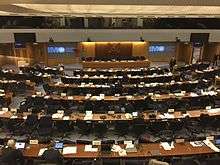
The technical work of the International Maritime Organisation is carried out by a series of Committees.[24][20] These include:
- The Maritime Safety Committee (MSC)
- The Marine environment Protection Committee (MEPC)
- The Legal Committee
- The Technical Cooperation Committee, for capacity building
- The Facilitation Committee, to simplify the documentation and formalities required in international shipping.
Maritime Safety Committee
It is regulated in the Article 28(a) of the Convention on the IMO:
ARTICLE 28
(a) The Maritime Safety Committee shall consider any matter within the scope of the Organization concerned with aids to navigation, construction and equipment of vessels, manning from a safety standpoint, rules for the prevention of collisions, handling of dangerous cargoes, maritime safety procedures and requirements, hydrographic information, log-books and navigational records, marine casualty investigation, salvage and rescue, and any other matters directly affecting maritime safety.
(b) The Maritime Safety Committee shall provide machinery for performing any duties assigned to it by this Convention, the Assembly or the Council, or any duty within the scope of this Article which may be assigned to it by or under any other international instrument and accepted by the Organization.
(c) Having regard to the provisions of Article 25, the Maritime Safety Committee, upon request by the Assembly or the Council or, if it deems such action useful in the interests of its own work, shall maintain such close relationship with other bodies as may further the purposes of the Organization
The Maritime Safety Committee is the most senior of these and is the main Technical Committee; it oversees the work of its nine sub-committees and initiates new topics. One broad topic it deals with is the effect of the human element on casualties; this work has been put to all of the sub-committees, but meanwhile, the Maritime Safety Committee has developed a code for the management of ships which will ensure that agreed operational procedures are in place and followed by the ship and shore-side staff.[20]
Sub-Committees
The MSC and MEPC are assisted in their work by a number of sub-committees which are open to all Member States.[24] The committees are:
- Sub-Committee on Human Element, Training and Watchkeeping (HTW)
- Sub-Committee on Implementation of IMO Instruments (III)
- Sub-Committee on Navigation, Communications and Search and Rescue (NCSR)
- Sub-Committee on Pollution Prevention and Response (PPR)
- Sub-Committee on Ship Design and Construction (SDC)
- Sub-Committee on Ship Systems and Equipment (SSE)
- Sub-Committee on Carriage of Cargoes and Containers (CCC)
The names of the IMO sub-committees were changed in 2013.[24] Prior to 2013 there were nine Sub-Committees as follows:
- Bulk Liquids and Gases (BLG)
- Carriage of Dangerous Goods, Solid Cargoes and Containers(DSC)
- Fire Protection (FP)
- Radio-communications and Search and Rescue (COMSAR)
- Safety of Navigation (NAV)
- Ship Design and Equipment (DE)
- Stability and Load Lines and Fishing Vessels Safety (SLF)
- Standards of Training and Watchkeeping (STW)
- Flag State Implementation (FSI)
Resolutions
Resolution MSC.255(84), of 16 May 2008, adopts the Code of the International Standards and Recommended Practices for a Safety Investigation into a Marine casualty or Marine Incident. It is also known as the Casualty Investigation Code.[25]
Use of the International System of Units
Sea transportation is one of few industrial areas that still commonly uses non-metric units such as the nautical mile (nmi) for distance and knots (kn) for speed or velocity. One nautical mile is approximately one minute of arc of latitude along any meridian arc, and is today precisely defined as 1852 meters (about 1.151 statute miles).
In 1975, the assembly of the IMO decided that future conventions of the International Convention for the Safety of Life at Sea (SOLAS) and other IMO instruments should use SI units only.[26]
See also
- IMO ship identification number
- International Maritime Law Institute
- International Maritime Rescue Federation
- United Nations Convention on the Law of the Sea
- Standard Marine Communication Phrases developed by the IMO, to improve safety at sea
- NAVAREA
Notes and references
- "Introduction to IMO". International Maritime Organization. Retrieved 28 August 2015.
- Hoffman, Michael L. (4 March 1948). "Ship Organization Nears Final Form; U.N. Maritime Body Expected to Have 3 Principal Organs – Panama in Opposition". The New York Times. p. 51. Retrieved 28 August 2015.
- "History of IMO". IMO. IMO. 2015. Retrieved 3 June 2015.
- "IMO History in Pictures" (PDF). International Maritime Organization. Retrieved 27 October 2016.
- "MARPOL73-78: Brief history – list of amendments to date and where to find them". IMO. March 2012. Retrieved 1 June 2015.
- "IMO History: 30 years" (PDF). International Maritime Organization. Retrieved 27 October 2016.
- "IMO Building History". International Maritime Organization. Retrieved 27 October 2016.
- "Membership". International Maritime Organization. Retrieved 20 March 2020.
- "Member States". International Maritime Organization. Retrieved 28 August 2015.
- https://treaties.un.org/doc/Publication/CN/1961/CN.144.1961-Eng.pdf
- "Archived copy" (PDF). Archived from the original (PDF) on 7 June 2019. Retrieved 27 November 2019.CS1 maint: archived copy as title (link)
- "Structure". IMO. 1 January 2012. Retrieved 3 October 2012.
- "About us". International Oil Compensation Funds. Retrieved 3 May 2016.
- Nairobi International Convention on Removal of Wrecks (PDF), retrieved 10 February 2014
- SustainableShipping: (S) News – IMO targets greenhouse gas emissions (17 Jun 2008) – The forum dedicated to marine transportation and the environment
- "IMO at COP21 statement". IMO. 2015. Retrieved 31 December 2019.
- Offshore Carbon: Why a Climate Deal for Shipping is Sinking (Climate Home)
- "Ballast water management - the control of harmful invasive species". International Maritime Organization. Retrieved 7 July 2017.
- Archived 16 May 2013 at the Wayback Machine
- "The International Maritime Organization". Marine.gov.uk. 28 July 2007. Archived from the original on 31 October 2012. Retrieved 3 October 2012.
- Personal Page of the Secretary-General, accessed: 9 July 2020
- Press-Briefing "Positional changes at IMO Secretariat", accessed: 30 January 2012
- acting, following death of Mr Nielsen
- "Structure of IMO". International Maritime Organization. Retrieved 25 October 2016.
- "RESOLUTION MSC.255(84)" (PDF). Archived from the original (PDF) on 1 March 2012. Retrieved 3 October 2012.
- "Resolution A.351(IX) Use of metric units in the SI system in the International Convention for the Safety of Life at Sea, 1974, and other future instruments" (PDF). Assembly Resolutions. International Maritime Organization. 12 November 1975. Retrieved 4 September 2012.
Further reading
- Jack Corbett, Mélodie Ruwet, Yi-Chong Xu & Patrick Weller (2020) Climate governance, policy entrepreneurs and small states: explaining policy change at the International Maritime Organisation, Environmental Politics, 29:5, 825-844
- Mankabady, Samir. (1986). The International Maritime Organization. London: Routledge. ISBN 978-0-7099-3591-9
- Nordquist, Myron H. and John Morton Moore. (1999). Current Maritime Issues and the International Maritime Organization. The Hague: Martinus Nijhoff Publishers. ISBN 978-90-411-1293-4 OCLC: 42652709
- International Maritime Committee